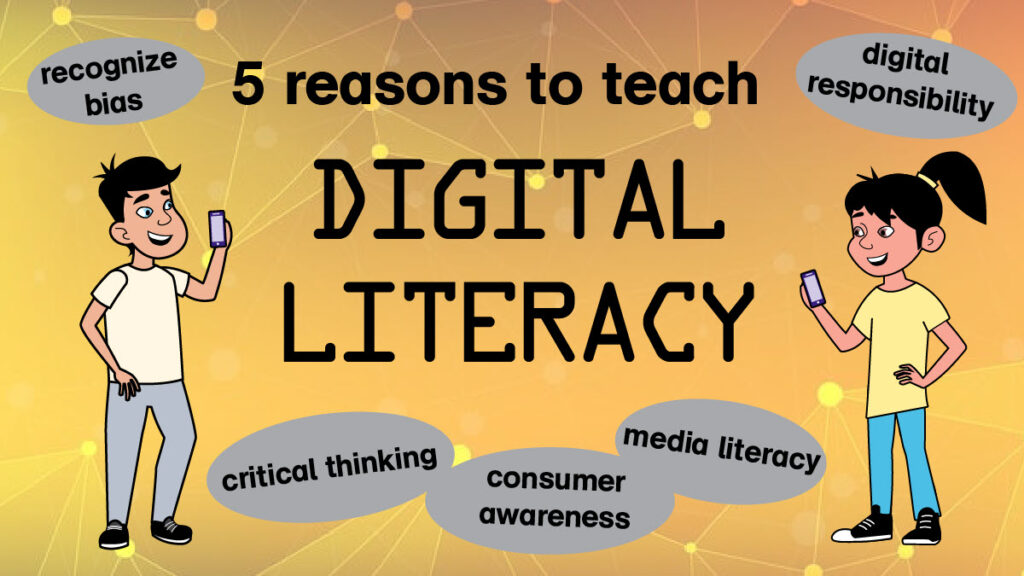Media literacy skills are the competencies needed to critically analyze and evaluate online content. Our students are a generation of young people who are enveloped with media content daily. As it is such a substantial part of their lives, their media exposure has a considerable effect. Developing media awareness is an essential skill for both their careers and their personal lives.
Here are 5 reasons why teachers should include media literacy lessons in curriculum.
1. Boost Critical Thinking
Anyone reading online information should analyze, question, and evaluate the content. We know that anyone can post anything online. So it is important for students to establish whether a website is credible and reliable. Show them how to question:
- Web Address – Is it a well-known organization or publication that can be trusted, such as a .org or .edu suffix as opposed to a .com suffix?
- Author – Is the writer an expert on the topic? Has he listed his job title, education, place of work, or contact information?
- Sources – Have the sources of facts been cited? Are the sources current and up to date? Are there links to the sources?
TechnoKids projects TechnoInternet, TechnoResearch, and TechnoEarth include trust tests that students apply to websites. They complete a checklist to determine if a site can probably be expected to have accurate and credible information.
2. Become a Responsible Digital Creator
The Internet allows students to publish to an enormous audience with a powerful effect. We want them to use this opportunity to engage others in real-world issues. TechnoEarth and TechnoEnvironment, for example, give students the ability to become environmental stewards and publish a call to action about a critical issue. They can engage, inform, and inspire an infinite community for the common good. Encourage students to become experts and take a leadership role. In addition, their positive impact on their online viewers can result in improved self-esteem.
At the same time, students need to understand copyright and data privacy rules. Published information should be reliable and fact-based. Sources should always be cited, whether required or not.
Often, school assignments have students create a project and post it online. Before doing so, they must have developed the digital literacy skills to know what is safe, honest, fair, constructive, and legal.
3. Identify the Effects of Media
Young people should not only be aware of the negative effects of media, especially social media, but also how to react. Peer pressure and cyberbullying are some of the unwanted and unhealthy messages they may receive. Openly and explicitly discussing these hazards in class will help kids to know what to do if they encounter such problems.
TechnoInternet has specific assignments on how to prevent cyperbullying, chat guidelines and safety tips, and how to email responsibly and with proper netiquette.
But there are also positive effects. Online connections can help students who feel isolated, shy, or depressed find others who feel the same in healthy and helpful forums. They can find sources of advice, facts, and help from experts. One example is a homework helper called Socratic. Students download the app and can ask questions in a wide variety of curriculum areas. Help is provided in step by step guides, visuals, and video tutorials.
4. Recognize Perspective
When students view online content, they should question whether the author is listing objective facts, or whether the site is advocating a particular viewpoint. Being able to distinguish between impartial data and media that promotes a slanted perspective is an essential life skill.
Practicing to defend a point of view is a great way to build this skill. In TechnoDebate, students prepare a convincing animated debate on a controversial issue. They each state their argument in a respectful and informed manner supported by accurate facts. Thereby, students learn how to identify not only viewpoints but also how they can be applied as an effective communication skill.
Finally, perspective recognition teaches empathy. By understanding the frame of reference of an author’s blog or website, students build an appreciation for others’ experiences, cultures, and lifestyles.
5. Raise Consumer Awareness
Another critical life skill is the ability to recognize advertising techniques. Specific lessons about marketing strategies help young people to make informed and responsible decisions. They need to be able to identify media messages. As a result, they can become savvy consumers who are critical of what they are exposed to online. This can be in the form of video ads, video games, media posts, text messages, memes, viral videos, and more. Students with strong media literacy skills are less likely to be influenced by advertisers’ techniques.

Just Released: New Media Literacy Project
In TechnoAd, students become digital marketers. They learn media literacy skills in a real world assignment of creating a short video ad for a product of their choice. Digital literacy, data analysis, video production, and word processing skills are blended in an authentic task:
- analyze selling tactics
- uncover hidden messages
- detect stereotypes
- investigate a target audience
- learn and apply camera techniques
- collaborate to storyboard and script an ad
- build video editing skills
- prepare a marketing campaign report
Media Literacy Blogs
Also, have a look at:
